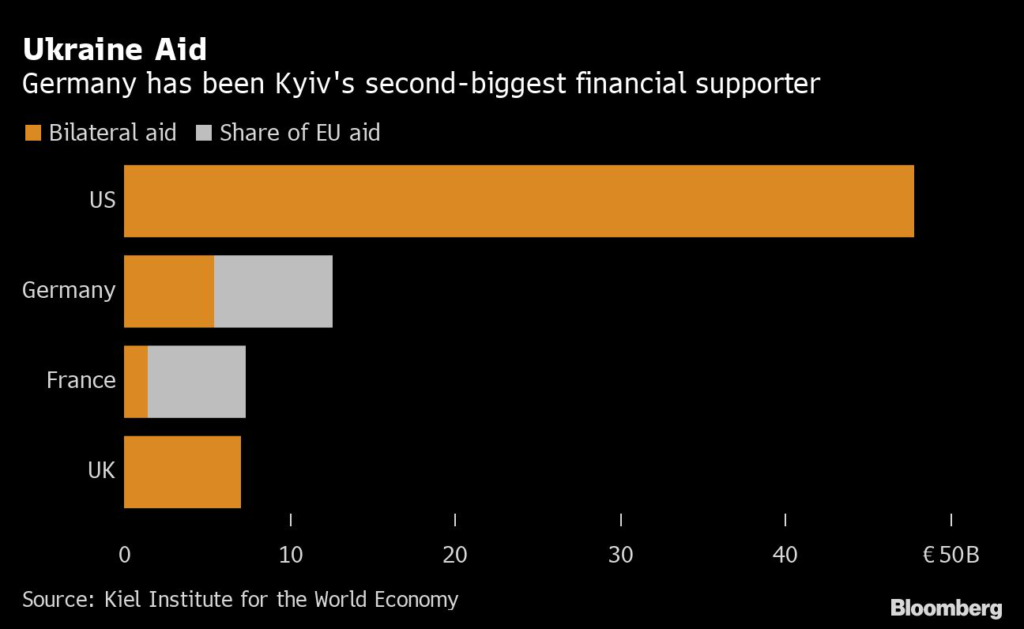Germany aims to deliver as many as 40 combat vehicles and a Patriot air-defense system to Ukraine by the end of March as part of an effort to help the government in Kyiv in the event fighting intensifies in the spring.
(Bloomberg) — Germany aims to deliver as many as 40 combat vehicles and a Patriot air-defense system to Ukraine by the end of March as part of an effort to help the government in Kyiv in the event fighting intensifies in the spring.
The government in Berlin announced late Thursday in a joint statement with the US that it will supply Ukraine with Marder infantry fighting vehicles, as well as the Patriot. The US will contribute Bradley Fighting Vehicles, providing a significant upgrade in firepower in the fight against Russia’s invasion along with similar armored AMX-10RCs France pledged on Wednesday.
“Especially in large urban centers, the civilian population will be better protected against the seemingly endless Russian aerial attacks,” Defense Minister Christine Lambrecht said in a statement after she spoke by phone with US Defense Secretary Lloyd Austin.
Chancellor Olaf Scholz held a phone call with Ukrainian President Volodymyr Zelenskiy, promising “steadfast solidarity” with Kyiv as his government continues its support in 2023, putting Germany’s total aid last year at 12 billion euros ($12.7 billion), according to a statement. The German leader was praised by domestic allies for the move, although some said it should have come much sooner and urged the government to supply even heavier kit, such as NATO-grade Leopard 2 battle tanks.
The Russian embassy in Berlin condemned Germany’s decision, saying on Friday that it “will seriously affect German-Russian relations” and calling it “a further step towards escalation of the conflict.”
“It is particularly cynical that this decision was taken shortly before the Orthodox Christmas holiday, which is highly revered in the Christian world, and against the backdrop of the cease-fire unilaterally declared by the Russian president,” the embassy said in a statement on its website.
Scholz’s chief spokesman Steffen Hebestreit said Friday that Germany and its allies had been discussing the latest arms shipment for several weeks.
German troops will start training their Ukrainian counterparts on how to operate the Marders soon, and the courses will take eight weeks, he told reporters in Berlin, adding that the goal is to have the Marders and the Patriot in Ukraine by the end of the first quarter.
Zelenskiy said on Twitter that his phone conversation with Scholz dealt with the defense package and “further cooperation.”
The US has been pushing European allies to send more heavy weapons to Ukraine because it wants to enable the army there to regain as much territory as possible before any negotiations with Russia, according to a senior German government official, who asked not to be identified discussing confidential policy details.
Scholz was previously reluctant to deliver combat vehicles, arguing that Germany shouldn’t act unilaterally and that any decision should be coordinated with European Union and NATO partners.
Thursday’s announcement places Germany alongside the US in providing critical offensive and defensive kit and may spur other European nations to step up their contributions.
Marie-Agnes Strack-Zimmermann, a member of Scholz’s FDP coalition partner, said she was “relieved” by the move to send Marders, and called on the government to immediately add Leopard tanks to the package. If Germany gave the green light, other allies would follow suit and send their Leopards, she said Friday in an interview with public broadcaster NDR.
“If these are delivered in a later installment we’ll lose even more time and that is the big problem,” added Strack-Zimmermann, who chairs the lower house of parliament’s defense committee. “As long as Russia is attacking Ukraine we have to do everything that is in our power.”
Overall, Germany has been one of the most generous supporters of Ukraine, sending billions of euros in financial support and humanitarian aid alongside military equipment. The list of kit includes 30 Gepard armored anti-aircraft vehicles, 14 self-propelled howitzers, the IRIS-T air-defense missile system and five MARS II multiple-rocket launchers.
The decision on the Marders marks the biggest step yet for Scholz and is a decisive shift from his more cautious predecessor, Angela Merkel, who argued that deepening economic ties with Russia would mitigate the risk of military aggression.
Scholz is also attempting to deliver on his pledge in the early days of Russia’s invasion to strengthen Germany’s military after years of underfunding.
A quarter of German voters believe the government should be doing more to help Ukraine’s military, according to the latest infratest dimap poll for ARD conducted Jan. 2-4. However, a slightly higher proportion, or 26%, think that the support already goes too far, while just over 40% consider it appropriate at the current level.
Anton Hofreiter, a member of Scholz’s Greens coalition partner, was more critical, saying it had come “very, very late.” He urged the chancellor to match French President Emmanuel Macron in “showing leadership.”
“We have to be very clear that if these combat vehicles had been delivered sooner then fewer Ukrainian soldiers would have died,” Hofreiter, who heads parliament’s EU committee, said Friday in an interview with public broadcaster ARD.
“It would have also enabled the Ukrainians to liberate more occupied areas and free the people more quickly from Russian terror,” he added. “At the very least, we should immediately start training Ukrainian troops on the Leopard 2.”
–With assistance from Arne Delfs and Samy Adghirni.
(Updates with Lambrecht quote, Russian embassy reaction from third paragraph.)
More stories like this are available on bloomberg.com
©2023 Bloomberg L.P.










